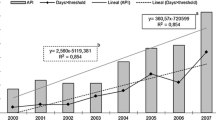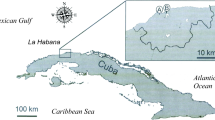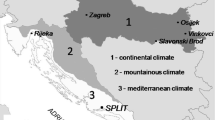Abstract
Pollen counts in Burgundy were monitored by means of four Hirst volumetric traps. Their analysis revealed a sharp rise of Ambrosia from 1996 to 1997. The minimum amount of ragweed pollen likely to provoke allergies (13 grains m−3) was reached or exceeded several days every year, but without leading to clinical symptoms. The circadian variation of Ambrosia pollen showed two peaks: the first one in the morning was suggested to coincide with local pollination, although the second one, in the afternoon, seemed to result from a long range transport which was confirmed by the study of wind roses.
Similar content being viewed by others
References
Banken R. and Comtois P.: 1990, Concentration du pollen de l'herbe à poux et prévalence de la rhinite allergique dans deux municipalités des Laurentides. Allergie et Immunol. 24(3), 91–94.
Besancenot J.P., Laaidi K. and Laaidi M.: 1997, Deux années de recherches sur pollens et pollinoses en Bourgogne. Compterendu de la réunion annuelle du R.N.S.A., 59–61.
Bugnon F., Felzines J.C., Loiseau J.E. and Royer J.M.: 1993, Nouvelle flore de Bourgogne. I. Catalogue général et fichier bibliographique. Bulletin Scientifique de Bourgogne, Dijon, 217 pp.
Comtois P.: 1995, The experimental research of Charles H. Blackley. Aerobiologia 11, 63–68.
Comtois P. and Gagnon L.: 1988, Concentration pollinique et fréquence des symptômes de pollinose: une méthode pour déterminer les seuils cliniques. Rev. fr. Allergol. 28(4), 279–286.
Déchamp C.: 1995, L'ambroisie, un nouveau fléau. Ed. Verso, Ahum, 94 pp.
Jäger S.: 1991, Allergenic significance of Ambrosia (Ragweed) pollen. In: G. D'Amato, F.Th.M. Spieksma and S. Bonini (eds), Allergenic Pollen and Pollinosis in Europe. Blackwell Scientific Publications, Oxford, London, Edinburgh, Boston, Melbourne, Paris, Berlin, Vienna, pp. 125–127.
Jarai-Komlódi M.: 1993, Ambrosia elatior (L.) in Hungary (1989–1990). Aerobiologia 9(1), 75–78.
Käpylä M. and Penttinen A.: 1981, An evaluation of the microscopical counting methods of the tape in Hirst-Burkard pollen and spore trap. Grana 20(2), 131–141.
Laaidi K.: 1997, Les pollinoses en Haute-Bourgogne: saison 1996. Climat et Santé 17, 27–40.
Laaidi M.: 1997/1998, Comparaison des comptes polliniques de Dijon sur deux années, 1996 et 1997. Climat et Santé 18, 21–36.
Solomon W.R.: 1984, Aerobiology of pollinosis. J. Allergy Clin. Immunol. 74(4), 449–461.
Thibaudon M.: 1992, Ambrosia en France; quelques données aéropolliniques pour les années 1987 à 1990. Allergie et Immunol. 24(1), 9–16.
Touraine R.: 1984, La pollinose à Ambrosia. Allergie et Immunol. 16(5), 275–276.
Zetterström O.: 1988, The increased prevalence of allergic disease. Allergy 43, 10–11.
Author information
Authors and Affiliations
Rights and permissions
About this article
Cite this article
Laaidi, K., Laaidi, M. Airborne pollen of Ambrosia in Burgundy (France) 1996–1997. Aerobiologia 15, 65–69 (1999). https://doi.org/10.1023/A:1007547919559
Issue Date:
DOI: https://doi.org/10.1023/A:1007547919559




